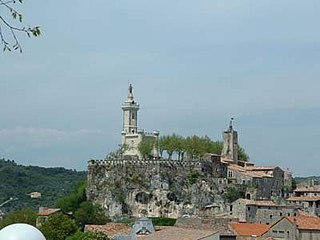
Saint-Gilles or Saint-Gilles-du-Gard is a commune in the Gard department in southern France.

Saint-Victor-la-Coste is a commune in the Gard department in the Occitania region in Southern France.

Montluçon is a commune in central France on the river Cher. It is the largest commune in the Allier department, although the department's prefecture is located in the smaller town of Moulins. Its inhabitants are known as Montluçonnais. The town is in the traditional province of Bourbonnais and was part of the mediaeval duchy of Bourbon.

Vallabrègues is a commune in the Gard department in southern France.

Aiguèze is a commune in the Gard department in the Occitanie region of Southern France. Since 2005, Aiguèze has been a member of Les Plus Beaux Villages de France, the first such location in Gard.

Vézénobres is a commune in the Gard department in the Occitania region in Southern France.

Sauveterre is a commune in the Gard department in southern France.

Langlade is a commune and a village in the Gard department in southern France located some 15 km (9.3 mi) southwest of Nîmes. The village is situated in an area of low hills and plains known as the Vaunage and has existed since at least 1125. It was built near to a Roman road and had a small church at its centre. In the 17th century a staging point was set up on the Roman road nearby and later a station was built in the village on the railway line connecting Nîmes to Roquefort. The station closed in 1987. Much of the local area is devoted to the cultivation of grapes. From a hamlet with fewer than 400 inhabitants in the 1960s, the village has grown considerably, so that by 2008 it had 1,993 inhabitants.

Générac is a commune in the Gard department in southern France. Générac station has rail connections to Nîmes and Le Grau-du-Roi. Tenor Eustase Thomas-Salignac (1867–1943) was born in Générac.

Le Cailar is a commune in the Gard department in southern France. It is located at the confluence of the River Vistre and the River Rhôny. It was an important port during the Iron Age at a time when lagoons connected to the Mediterranean Sea covered the adjoining low-lying land.

Berné is a commune in the Morbihan department in Brittany in northwestern France.

Montdardier is a commune in the Gard department in southern France.

Saint-Jean-de-Valériscle is a commune in the Gard department in the Occitania region in Southern France. In 2021, it had a population of 599.

Mialet is a commune in the Gard department in southern France.

Rousson is a commune in the Gard department in southern France.

Saint-Ambroix is a commune in the Gard department in southern France.

Ambrugeat is a commune in the Corrèze department in the Nouvelle-Aquitaine region of central France.

Arcens is a commune in the Ardèche department in the Auvergne-Rhône-Alpes region of southern France.

Fanlac is a commune in the Dordogne department in Nouvelle-Aquitaine in southwestern France.

Aghione is a commune in the Haute-Corse department of France on the island of Corsica.
























